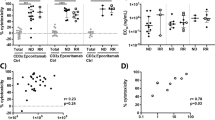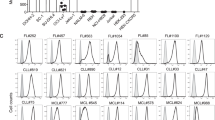Abstract
Adoptive immunotherapy with Epstein–Barr virus (EBV)-specific cytotoxic T cells (CTL) is effective for the prophylaxis and treatment of EBV-induced lymphoma in hematopoietic stem cell recipients. However, in EBV-positive Hodgkin's disease (HD) the efficacy of adoptively transferred EBV-specific CTL may be limited by tumor-derived immunosuppressive factors, such as T-cell growth factor (TGF) β, interleukin (IL)13 and the chemokine TARC. Local delivery of IL12 to tumor sites by tumor-specific CTL could provide direct antitumor effects and overcome the CTL-inhibitory effects of the Th2 tumor environment while avoiding the systemic toxicity of recombinant IL12. EBV-specific CTL transduced with a retrovirus vector expressing the p40 and p35 subunits of IL12 as a single molecule (Flexi-IL12), produced IL12 following antigenic stimulation. This resulted in an elevated production of Th1 cytokines, including interferon γ and tumor necrosis factor α, and a reduction in the Th2 cytokines IL4 and IL5. Flexi-IL12-transduced CTL resisted the antiproliferative and anticytotoxic effects of exogenous TGFβ, likely by antagonizing the TGFβ-induced downregulation of the Th1 transcriptional factor T-bet. In addition, Flexi-IL12-transduced CTL demonstrated a proliferative advantage in the presence of inhibitory supernatants from HD-derived cell lines. Tumor-specific, Flexi-IL12-transduced EBV-specific CTL should have a functional advantage over unmodified CTL, particularly in the presence of the adverse Th2 cytokine environment produced by Hodgkin tumor cells.
This is a preview of subscription content, access via your institution
Access options
Subscribe to this journal
Receive 12 print issues and online access
$259.00 per year
only $21.58 per issue
Buy this article
- Purchase on Springer Link
- Instant access to full article PDF
Prices may be subject to local taxes which are calculated during checkout







Similar content being viewed by others
References
Riddell SR, Greenberg PD . Principles for adoptive T cell therapy of human viral diseases. Annu Rev Immunol. 1995;13:545–586.
Rooney CM, Aguilar LK, Huls MH, Brenner MK, Heslop HE . Adoptive immunotherapy of EBV-associated malignancies with EBV-specific cytotoxic T-cell lines. Curr Top Microbiol Immunol. 2001;258:221–229.
Perez-Diez A, Marincola FM . Immunotherapy against antigenic tumors: a game with a lot of players. Cell Mol Life Sci. 2002;59:230–240.
Poppema S, van den Berg A . Interaction between host T cells and Reed-Sternberg cells in Hodgkin lymphomas. Semin Cancer Biol. 2000;10:345–350.
Nestle FO . Dendritic cell vaccination for cancer therapy. Oncogene. 2000;19:6673–6679.
Mosmann TR, Li L, Sad S . Functions of CD8 T-cell subsets secreting different cytokine patterns. Semin Immunol. 1997;9:87–92.
Dong C, Flavell RA . Th1 and Th2 cells. Curr Opin Hematol. 2001;8:47.
Kobayashi M, Fitz L, Ryan M, et al. Identification and purification of natural killer cell stimulatory factor (NKSF), a cytokine with multiple biologic effects on human lymphocytes. J Exp Med. 1989;170:827–845.
Stern AS, Podlaski FJ, Hulmes JD, et al. Purification to homogeneity and partial characterization of cytotoxic lymphocyte maturation factor from human B-lymphoblastoid cells. Proc Natl Acad Sci USA. 1990;87:6808–6812.
Banks RE, Patel PM, Selby PJ . Interleukin 12: a new clinical player in cytokine therapy. Br J Cancer. 1995;71:655–659.
Voest EE, Kenyon BM, O'Reilly MS, Truitt G, D'Amato RJ, Folkman J . Inhibition of angiogenesis in vivo by interleukin 12. J Natl Cancer Inst. 1995;87:581–586.
Leonard JP, Sherman ML, Fisher GL, et al. Effects of single-dose interleukin-12 exposure on interleukin-12-associated toxicity and interferon-gamma production. Blood. 1997;90:2541–2548.
Herbst H, Dallenback F, Hummel M, et al. Epstein–Barr virus latent membrane protein expression in Hodgkin and Reed-Sternberg cells. Proc Natl Acad Aci USA. 1991;88:4766–4770.
Roskrow MA, Suzuki N, Gan Y-J, et al. EBV-specific cytotoxic T lymphocytes for the treatment of patients with EBV positive relapsed Hodgkin's disease. Blood. 1998;91:2925–2934.
Newcom SR, Gu L . Transforming growth factor beta 1 messenger RNA in Reed-Sternberg cells in nodular sclerosing Hodgkin's disease. J Clin Pathol. 1995;48:160–163.
Skinnider BF, Elia AJ, Gascoyne RD, et al. Interleukin 13 and interleukin 13 receptor are frequently expressed by Hodgkin and Reed-Sternberg cells of Hodgkin lymphoma. Blood. 2001;97:250–255.
Peh SC, Kim LH, Poppema S . TARC, a CC chemokine, is frequently expressed in classic Hodgkin's lymphoma but not in NLP Hodgkin's lymphoma, T-cell-rich B-cell lymphoma, and most cases of anaplastic large cell lymphoma. Am J Surg Pathol. 2001;25:925–929.
Bramson JL, Hitt M, Addison CL, Muller WJ, Gauldie J, Graham FL . Direct intratumoral injection of an adenovirus expressing interleukin-12 induces regression and long-lasting immunity that is associated with highly localized expression of interleukin-12. Hum Gene Ther. 1996;7:1995–2002.
Wolf J, Kapp U, Bohlen H, et al. Peripheral blood mononuclear cells of a patient with advanced Hodgkin's lymphoma give rise to permanently growing Hodgkin–Reed Sternberg cells. Blood. 1996;87:3418–3428.
Drexler HG, Gaedicke G, Lok MS, Diehl V, Minowada J . Hodgkin's disease derived cell lines HDLM-2 and L-428: comparison of morphology, immunological and isoenzyme profiles. Leuk Res. 1986;10:487–500.
Anderson R, Macdonald I, Corbett T, Hacking G, Lowdell MW, Prentice HG . Construction and biological characterization of an interleukin-12 fusion protein (Flexi-12): delivery to acute myeloid leukemic blasts using adeno-associated virus. Hum Gene Ther. 1997;8:1125–1135.
Riviere I, Brose K, Mulligan RC . Effects of retroviral vector design on expression of human adenosine deaminase in murine bone marrow transplant recipients engrafted with genetically modified cells. Proc Natl Acad Sci USA. 1995;92:6733–6737.
Rossig C, Bollard CM, Nuchtern JG, Rooney CM, Brenner MK . Epstein–Barr virus-specific human T lymphocytes expressing antitumor chimeric T-cell receptors: potential for improved immunotherapy. Blood. 2002;99:2009–2016.
Bollard CM, Rossig C, Calonge MJ, et al. Adapting a transforming growth factor beta-related tumor protection strategy to enhance antitumor immunity. Blood. 2002;99:3179–3187.
Jin Y, Fuller L, Carreno M, Esquenazi V, Tzakis AG, Miller J . The regulation of phenotype and function of human liver CD3+/CD56+ lymphocytes, and cells that also co-express CD8 by IL-2, IL-12 and anti-CD3 monoclonal antibody. Hum Immunol. 1998;59:352–362.
Jabs WJ, Hennig H, Kittel M, et al. Normalized quantification by real-time PCR of Epstein–Barr virus load in patients at risk for posttransplant lymphoproliferative disorders. J Clin Microbiol. 2001;39:564–569.
Livak KJ, Schmittgen TD . Analysis of relative gene expression data using real-time quantitative PCR and the 2(-Delta Delta C(T)) method. Methods. 2001;25:402–408.
Lee SP, Tierney RJ, Thomas WA, Brooks JM, Rickinson AB . Conserved CTL epitopes within EBV latent membrane protein 2: a potential target for CTL-based tumor therapy. J Immunol. 1997;158:3325–3334.
Pollok KE, van der Loo JC, Cooper RJ, Kennedy L, Williams DA . Costimulation of transduced T lymphocytes via T cell receptor–CD3 complex and CD28 leads to increased transcription of integrated retrovirus. Hum Gene Ther. 1999;10:2221–2236.
Gorelik L, Constant S, Flavell RA . Mechanism of transforming growth factor beta-induced inhibition of T helper type 1 differentiation. J Exp Med. 2002;195:1499–1505.
Kemp RA, Ronchese F . Tumor-specific Tc1, but not Tc2, cells deliver protective antitumor immunity. J Immunol. 2001;167:6497–6502.
Stewart JP, Rooney CM . The interleukin-10 homolog encoded by Epstein–Barr virus enhances the reactivation of virus-specific cytotoxic T cell and HLA-unrestricted killer cell responses. Virology. 1992;191:773–782.
Santin AD, Hermonat PL, Ravaggi A, et al. Interleukin-10 increases Th1 cytokine production and cytotoxic potential in human papillomavirus-specific CD8(+) cytotoxic T lymphocytes. J Virol. 2000;74:4729–4737.
Colombo MP, Trinchieri G . Interleukin-12 in anti-tumor immunity and immunotherapy. Cytokine Growth Factor Rev. 2002;13:155–168.
Kang WK, Park C, Yoon HL, et al. Interleukin 12 gene therapy of cancer by peritumoral injection of transduced autologous fibroblasts: outcome of a phase I study. Hum Gene Ther. 2001;12:671–684.
Harries M, Phillipps N, Anderson R, Prentice G, Collins M . Comparison of bicistronic retroviral vectors containing internal ribosome entry sites (IRES) using expression of human interleukin-12 (IL-12) as a readout. J Gene Med. 2000;2:243–249.
Chapman AL, Rickinson AB, Thomas WA, Jarrett RF, Crocker J, Lee SP . Epstein–Barr virus-specific cytotoxic T lymphocyte responses in the blood and tumor site of Hodgkin's disease patients: implications for a T-cell-based therapy. Cancer Res. 2001;61:6219–6226.
Smits HH, van Rietschoten JG, Hilkens CM, et al. IL-12-induced reversal of human Th2 cells is accompanied by full restoration of IL-12 responsiveness and loss of GATA-3 expression. Eur J Immunol. 2001;31:1055–1065.
Sudarshan C, Galon J, Zhou Y, O'Shea JJ . TGF-beta does not inhibit IL-12- and IL-2-induced activation of Janus kinases and STATs. J Immunol. 1999;162:2974–2981.
Xu J, Menezes J, Prasad U, Ahmad A . Elevated serum levels of transforming growth factor beta 1 in Epstein–Barr virus-associated nasopharyngeal carcinoma patients. Int J Cancer. 1999;84:396–399.
Maggi E, Manetti R, Annunziato F, Romagnani S . CD8+ T lymphocytes producing Th2-type cytokines (Tc2) in HIV-infected individuals. J Biol Regul Homeost Agents. 1995;9:78–81.
Kinsella TM, Nolan GP . Episomal vectors rapidly and stably produce high-titer recombinant retrovirus. Hum Gene Ther. 1996;7:1405–1413.
Rickinson AB, Moss DJ, Allen DJ, Wallace LE, Rowe M, Epstein MA . Reactivation of Epstein–Barr virus-specific cytotoxic T cells by in vitro stimulation with the autologous lymphoblastoid cell line. Int J Cancer. 1981;27:593–601.
Acknowledgements
This work was supported by a grant from the “Deutsche Forschungsgemeinschaft” to HJW (WA 1149/2-1), a grant from the “Association pour la Recherche sur le Cancer (ARC), France” to SV, a Translational Research Grant (# 6104-02) from the Leukemia and Lymphoma Society of America to CMR, POI CA94237 from the National Institutes of Health, a Distinguished Clinical Scientist Award from the Doris Duke Foundation to HEH and by the Center for Cell and Gene Therapy, Baylor College of Medicine.
Author information
Authors and Affiliations
Corresponding author
Rights and permissions
About this article
Cite this article
Wagner, HJ., Bollard, C., Vigouroux, S. et al. A strategy for treatment of Epstein–Barr virus-positive Hodgkin's disease by targeting interleukin 12 to the tumor environment using tumor antigen-specific T cells. Cancer Gene Ther 11, 81–91 (2004). https://doi.org/10.1038/sj.cgt.7700664
Received:
Published:
Issue Date:
DOI: https://doi.org/10.1038/sj.cgt.7700664
Keywords
This article is cited by
-
Programming CAR T cells to enhance anti-tumor efficacy through remodeling of the immune system
Frontiers of Medicine (2020)
-
Repurposing endogenous immune pathways to tailor and control chimeric antigen receptor T cell functionality
Nature Communications (2019)
-
Collapse of the Tumor Stroma is Triggered by IL-12 Induction of Fas
Molecular Therapy (2013)
-
Improving Adoptive T Cell Therapy by Targeting and Controlling IL-12 Expression to the Tumor Environment
Molecular Therapy (2011)
-
Immunotherapy for EBV-associated malignancies
International Journal of Hematology (2011)



